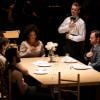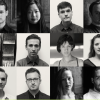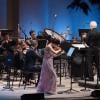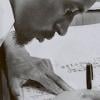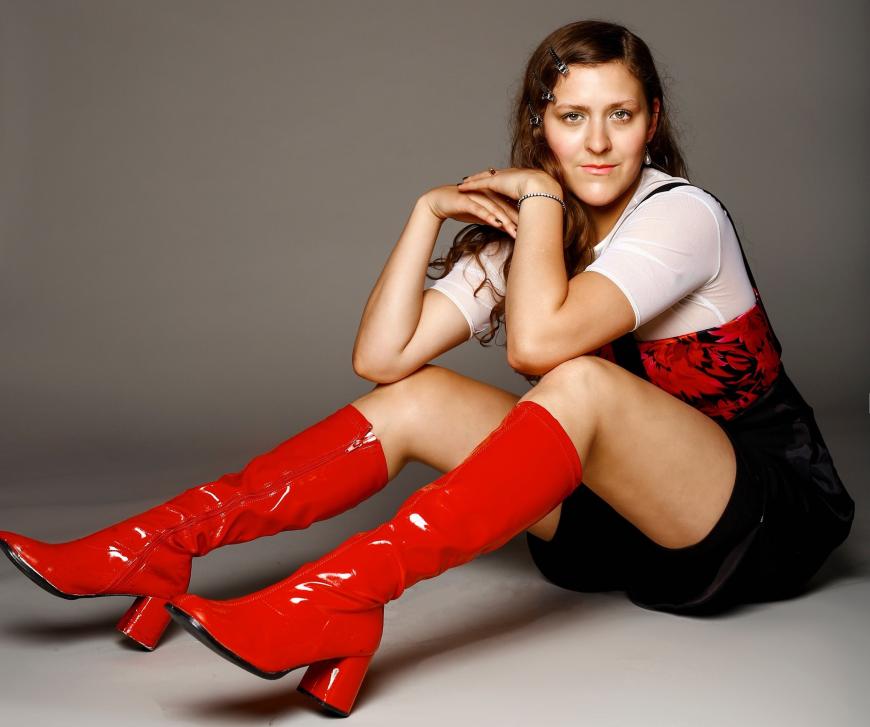
The perks of attending The Juilliard School include the opportunity to meet like-minded people in concentrated settings. Among the connections dancer/choreographer Julia Eichten made at Juilliard, where she received the 2011 Hector Zaraspe Award for achievement in choreography, was director Zack Winokur, who, in 2017, co-founded American Modern Opera Company, AMOC, with composer/conductor Matthew Aucoin.
And from June 9 through June 12, AMOC is serving as the Ojai Music Festival’s 2022 music director, the first explicitly interdisciplinary company to hold the position in the festival’s 75-year history. (Two previous ensembles to plan Ojai seasons were the Emerson Quartet in 2002 and Eighth Blackbird in 2009.) The 17-member company is made up of 10 instrumentalists, including violinist Keir GoGwilt and percussionist Jonny Allen, four vocalists, with soprano Julia Bullock, countertenor Anthony Roth Costanzo, and bass-baritone Davóne Tines among the bold-faced names, and a trio of dancer/choreographers — Bobbi Jene Smith, Or Schraiber, and Eichten.
Festival works on tap are as intriguing as they are varied, with opening night featuring a range of repertory including music by Iannis Xenakis, Frederoc Rzewski, and Bob Dylan, among others. On Friday, Julius Eastman fans will be treated to an early morning concert of works by the iconoclastic composer who died in 1990 at age 49 and has recently been rediscovered. The Saturday schedule also includes the first Ojai Festival performance of music by Southern California’s Andrew McIntosh.
For Eichten, who grew up in Minnesota and now calls Vermont home, AMOC is a perfect fit. Beginning her professional performance career with Camille A. Brown & Dancers and Azure Barton & Artists, the 33-year-old was also a founding member of the internationally renowned L.A. Dance Project, which launched in 2012 under the direction of Benjamin Millepied.
Although she left the troupe after five years, Eichten has not been wanting for work. Indeed, in 2019, she was the associate choreographer for Solange (Knowles) and the artist duo Gerard & Kelly, for the site-specific piece Bridge-s, at The Getty Center, and choreographed and performed under Winokur’s direction at American Repertory Theater in Cambridge, MA.
Among the topics Eichten and I discussed during a recent phone conversation were the festival, her collaborative artmaking process, and AMOC.
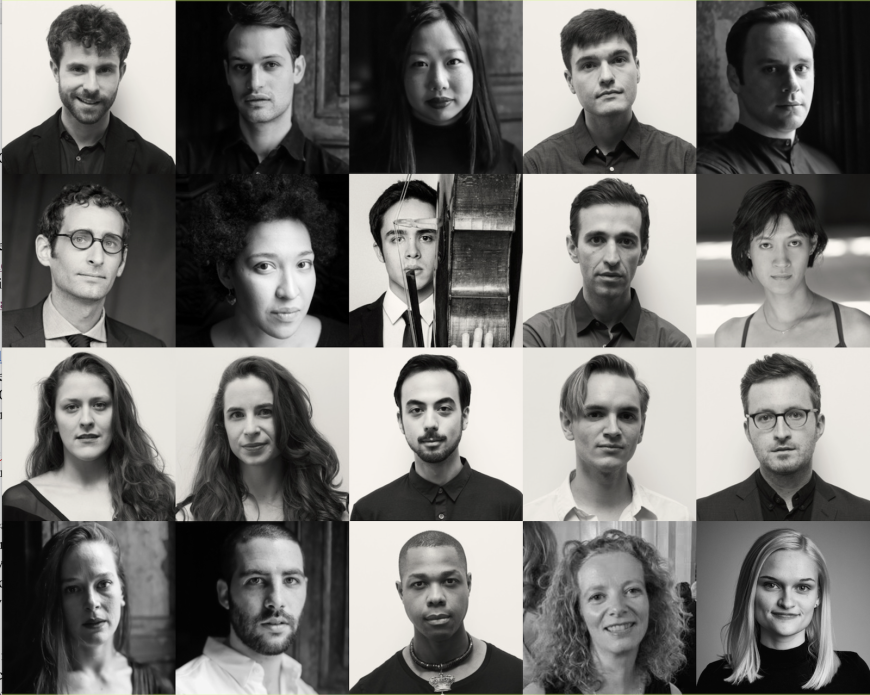
What was the genesis of AMOC and how does it work in terms of creating?
Over the past five years, and the reason we all came together, was that we were trying to figure out a way to produce our individual works. Zack gathered [those of] us who couldn’t get their needs met in a typical company setting and we all have multifaceted interests in how we are artists in the world. Our first big production since the pandemic, was The No One’s Rose, last fall at Stanford. There were 13 members, including Matt and Bobbi, and we worked with the Philharmonia Baroque Orchestra.
It was a wild time, since we all hadn’t been in the same room together in that way, but there were projects building up to it. With Broken Theater [the ongoing project with residencies at Mass MoCA and La Mama Experimental Theatre Club], there were five AMOC members, then outside dancers joined us. With all of these [works] we’ve continued to gather as a group and talk about how our processes unfold, what support we need, what we need less of.
There’s a steering committee with one representative from each discipline and it’s very democratic. For the Ojai duet I’m making with Brett [Easterling], we make a proposal and budget, and that goes to the steering committee. We have a vote and through that it moves forward. The goal of the company is to support things large and small, and everything else that lives inside us between those things.
Speaking of Bret Easterling, on Sunday, June 10, you and he are performing a duet, Dance in the Park, under the name Eichterling, in Libbey Park. Tell us about the dance and your working relationship with Bret.
We met at Juilliard and have been creative partners for the last 10 years [although] we had separate performance careers. He was with Batsheva [Dance Company] and I was with L.A. Dance Project. There was a moment when all of us were colleagues from Juilliard and we would come together in the summers to do a workshop where we could share and learn and continue our work even though we were separated geographically.
With Bret, all of our work has been entangled in a bit of humor — particularly how devastating the world is every day for so many people, so we wanted to focus intensely on joy, play, and togetherness and not take ourselves too seriously. That’s where we started. Every year we become the same age for six months, so we have endless notes of ideas. This year we happened to both be 33, so we were thinking about things happening in threes.
We made a phrase on one, two, and three, and got through 14 in that process. From there we started constructing something, but mostly in silence. Then we put the Blue Danube waltz to this thing we made, and from there we had phrases that tried to make a physical noise. We’re both musical, dynamic dancers, and I was really thinking about dance as music and music as dance. How do we stay between those things and blur that line? There’s also a big reveal that will be hard to miss.
Then there’s Open Rehearsal on Friday, June 10. It’s a new, hour-long collaborative dance-theater work by Bobbi Jene Smith featuring you and other AMOC members, along with guest collaborators. What can audiences expect to see?
We’re playing with the idea of rehearsal as performance, performance as rehearsal, hoping to blur those lines of when we’re ourselves, when we’re other versions of ourselves or characters we take on in the role. You get to see the work cracked open and maybe we’ll step inside of it and try it again. Maybe an argument will erupt, so anything is possible. It still is very much a performance, but you get to see us playing with what our interpretation is.
It sounds a tad improvisational.
There are elements of improvisation, but there’s still an immense amount of form and construction. All of those things that make a great dance, they’re all present. We, like musicians, like to have the form of whatever choreography is, and play inside of that. But if improv is present, how can that feel so solid and clear? [In any case], it will very much be a show, and the music includes works by Schubert, Bach, Connie Converse and Pete Seeger.
You’re also in the new 60-minute work, How to Fall Apart, on Saturday, June 11. It’s an AMOC commission, with a score by Carolyn Chen. The piece concerns the cosmic, natural, and human processes of disintegration, aging, and falling apart, all while integrating text, gesture, and music.
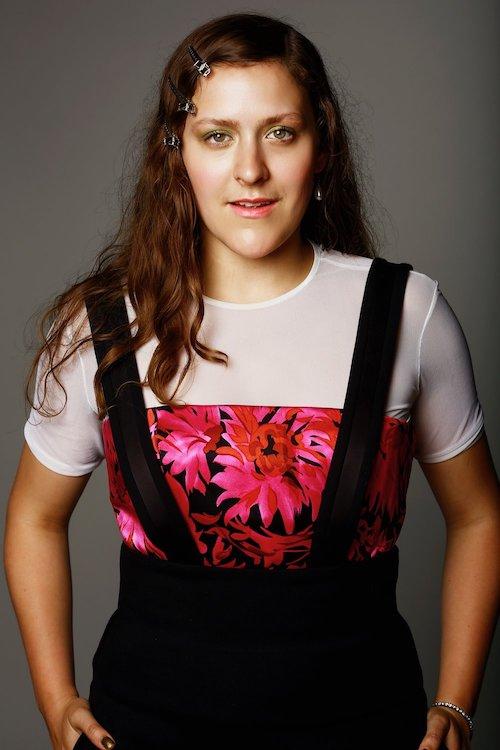
I serve as the movement director and I’m also performing inside of it. I’ve said this to Carolyn, that she sees how the music should live physically in space. She has a strong idea of what’s happening on stage and my job was to help facilitate that. She does wonderful things with her scores. There are three columns: The first is stick figure bodies and what scenario she sees; the second is a description of that movement; and the third is what music is happening at that time.
We’re dealing with global warming and its deterioration of us, of itself, and it’s put through a lens of many different interpretations. For instance, the expanding universe [can be a] croissant or raisin bread. It expands in the oven, but the raisins stay the same distance apart from one another. Carolyn brought so much research into the space. It’s a real collaboration between us that is the kind you dream about and is a dive deeper into her.
Pre-AMOC, in 2015, you made O’de, for L.A. Dance Project, a collaboration with the company and street dancer Lil Buck. The work actually took place at the Palace of Versailles, and was presented in concert with the inauguration of its renovated Water Theater grove. Since ballet began with Louis XIV at Versailles, performing there must have been extraordinary.
That was a day all of us performers will remember forever. They had done a competition across France for someone to design a new fountain for Versailles and Jean-Michel Othoniel won the commission. The space hadn’t been danced in since Louis XIV, literally, and we spent a lot of time studying old notations — the practice, what was their warm-up, connecting to the earth. Lil Buck was the perfect person to represent the sun god, because in so much of his work you can see Baroque influences, juking, how he works with spirals.
He connected the past and present to help us bring that vision to life. It was such a divine moment in time and with the company. We sadly never got to do it again, but it was so rich and so full, and at the end, boom, the fountains are on for the very first time. It was something, like many things, with L.A. Dance Project, that I could have never dreamt up, but the trust from Benjamin [Millepied], to carry out that vision made it beyond special. It’s still a fresh and magical memory.
Speaking of magical memories, I’m sure this edition of Ojai will be one for the books.
It is completely overwhelming. We spent so much time; we had an Ojai planning committee and there were many four-hour Zoom meetings about how we can take on this responsibility as an ensemble. There’s an intense sense of being overwhelmed, but also there’s a huge excitement, and a commitment to making this something, hopefully, people will remember and talk about.
Just to inspire and excite people about music and dancemaking in the now and how we are challenging and confronting those things. There’s such a sense of possibility with the festival and we all want to meet that. It’s a huge honor and we’re open to all the possibilities. We’re focusing as much as we can to do the best work we can, in a go-for-broke kind of way.


